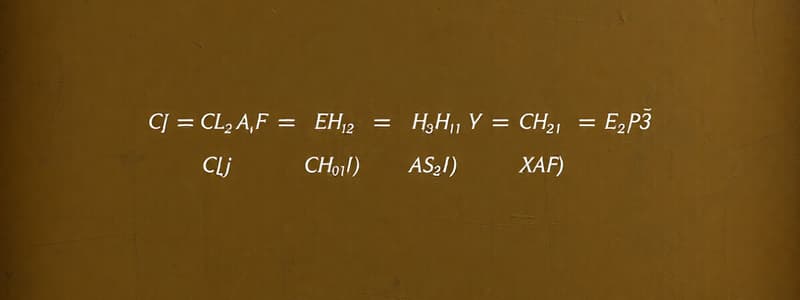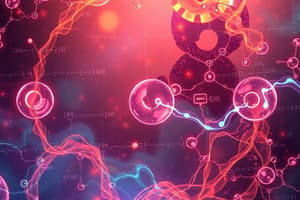Podcast
Questions and Answers
Which of the following is the correct balanced chemical equation for the reaction between magnesium (Mg) and oxygen gas (O2) to form magnesium oxide (MgO)?
Which of the following is the correct balanced chemical equation for the reaction between magnesium (Mg) and oxygen gas (O2) to form magnesium oxide (MgO)?
- 2Mg + O2 2MgO (correct)
- Mg + O2 MgO
- 2Mg + O MgO
- Mg + O2 2MgO
What is the correct chemical formula for copper(II) sulfate?
What is the correct chemical formula for copper(II) sulfate?
- CuSO4 (correct)
- Cu2SO4
- CuSO3
- Cu2SO3
In a chemical reaction, if the theoretical yield of a product is 25.0 grams, but only 20.0 grams are actually obtained, what is the percent yield?
In a chemical reaction, if the theoretical yield of a product is 25.0 grams, but only 20.0 grams are actually obtained, what is the percent yield?
- 75%
- 125%
- 20%
- 80% (correct)
Which quantum number describes the shape of an atomic orbital?
Which quantum number describes the shape of an atomic orbital?
Ionization energy generally increases as you move down a group (column) in the periodic table.
Ionization energy generally increases as you move down a group (column) in the periodic table.
According to VSEPR theory, what is the molecular shape of $H_2O$?
According to VSEPR theory, what is the molecular shape of $H_2O$?
What is the hybridization of the central carbon atom in carbon dioxide ($CO_2$)?
What is the hybridization of the central carbon atom in carbon dioxide ($CO_2$)?
In molecular orbital theory, what is the bond order of $H_2^+$?
In molecular orbital theory, what is the bond order of $H_2^+$?
According to the first law of thermodynamics, the internal energy of an isolated system is constant.
According to the first law of thermodynamics, the internal energy of an isolated system is constant.
State the first law of thermodynamics in equation form.
State the first law of thermodynamics in equation form.
In calorimetry, which formula is used to calculate the heat absorbed or released by a substance?
In calorimetry, which formula is used to calculate the heat absorbed or released by a substance?
Hess's Law states that:
Hess's Law states that:
The Born-Haber cycle is used to determine the ______ energy of ionic compounds.
The Born-Haber cycle is used to determine the ______ energy of ionic compounds.
Which of the following is the correct electron configuration of $Fe^{2+}$?
Which of the following is the correct electron configuration of $Fe^{2+}$?
Using bond energies, estimate the enthalpy change ($ \Delta H $) for the reaction: $H_2(g) + Cl_2(g) \rightarrow 2HCl(g)$. Given: Bond energy of H-H = 436 kJ/mol, Cl-Cl = 242 kJ/mol, and H-Cl = 431 kJ/mol.
Using bond energies, estimate the enthalpy change ($ \Delta H $) for the reaction: $H_2(g) + Cl_2(g) \rightarrow 2HCl(g)$. Given: Bond energy of H-H = 436 kJ/mol, Cl-Cl = 242 kJ/mol, and H-Cl = 431 kJ/mol.
Match the following terms with their descriptions:
Match the following terms with their descriptions:
What does a 'node' represent in the context of atomic orbitals?
What does a 'node' represent in the context of atomic orbitals?
The enthalpy of formation of an element in its standard state is always zero.
The enthalpy of formation of an element in its standard state is always zero.
Work done by the system on the surroundings is given a ______ sign.
Work done by the system on the surroundings is given a ______ sign.
Which of the following factors does NOT affect the lattice energy of an ionic compound?
Which of the following factors does NOT affect the lattice energy of an ionic compound?
Flashcards
Chemical Equation
Chemical Equation
Representation of a chemical reaction using symbols and formulas.
Nomenclature
Nomenclature
System of naming chemical compounds.
Stoichiometry
Stoichiometry
Calculations of reactants and products in chemical reactions.
Quantum Numbers
Quantum Numbers
Signup and view all the flashcards
Periodicity
Periodicity
Signup and view all the flashcards
VSEPR Theory
VSEPR Theory
Signup and view all the flashcards
Hybridization
Hybridization
Signup and view all the flashcards
Molecular Orbitals
Molecular Orbitals
Signup and view all the flashcards
First Law of Thermodynamics
First Law of Thermodynamics
Signup and view all the flashcards
Enthalpy
Enthalpy
Signup and view all the flashcards
Study Notes
- This is a study guide for the final exam
Chemical Equations
- Concerns writing, completing, and balancing chemical equations.
Nomenclature
- Concerns writing formulas from names and writing names from formulas.
Stoichiometry
- Concerns theoretical yield, percent yield, and limiting reagent problems
- Uses either mass or solution data.
Quantum Numbers
- Know what each number represents
- Ability to sketch orbital shapes and write electron configurations for both atoms and ions.
Periodicity
- Use the periodic trends to explain chemical behavior or predict chemical behavior.
VSEPR Theory
- Ability to identify molecular shapes.
Hybridization
- Ability to identify the orbital hybridization of the central atom in molecules.
Molecular Orbitals
- Ability to sketch molecular orbital diagrams for homonuclear and heteronuclear diatomic molecules.
The First Law of Thermodynamics
- Prepared to state the law as words or formula
- Includes calculations involving internal energy, heat, and work.
Enthalpy
- Includes calorimetric calculations, Hess’s Law calculations, enthalpy of reaction from enthalpy of formation tables, enthalpy of reaction from bond energies, and the Born-Haber cycle.
Studying That Suits You
Use AI to generate personalized quizzes and flashcards to suit your learning preferences.




